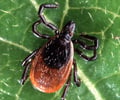Climatic changes may influence the infection rate of Lyme’s disease, finds a new study. It has been found that increases in temperature can boost infection rates of Lyme disease by 20 percent.

‘Climate change may affect the incidence of Lyme disease. Assuming that the temperature will rise by 2 degrees Celsius by mid-century the number of cases of Lyme disease in the United States will increase by about 21 percent by mid-century.’





A new study looked at the relationship between climatic variables and the incidence of Lyme disease in 15 U.S. states. The study found that rising temperatures are expected to boost the number of cases of Lyme disease by more than 20 percent by mid-century.The study, by researchers at Carnegie Mellon University and the Mayo Clinic College of Medicine and Science, appears in the Canadian Journal of Infectious Diseases and Medical Microbiology.
"A sizable increase in the incidence of cases of Lyme disease in the United States due to climate change is imminent," says Edson Severnini, assistant professor of economics and public policy at Carnegie Mellon University's Heinz College, who co-authored the study. "Our findings should alert clinicians, public health professionals, and policymakers, as well as the general public."
The number of reported cases of Lyme disease in the United States rose from 10,000 in 1991 to about 28,000 annually in the past five years. Growing evidence suggests that climate change may affect the incidence and prevalence of diseases like Lyme. This is because ticks spend most of their life cycle outside the host in an environment where temperature and humidity directly affect their development, activity, survival, and host-seeking behavior. In fact, the U.S. Environmental Protection Agency uses the number of cases of Lyme disease as an indicator of climate change.
To better understand the magnitude of the effect of climate change on incidences of Lyme disease, researchers examined the effect of climatic variables on frequency of the disease in 15 U.S. states with the highest incidence of Lyme disease; these 15 states, which are primarily in the Northeast and Upper Midwest, contribute to 95 percent of reported cases.
Advertisement
Assuming that the temperature will rise 2 degrees Celsius (3.6 degrees Fahrenheit) by mid-century, which is what the U.S. National Climate Assessment predicts will occur based on projection averages for the period 2036-2065, the study predicts that the number of cases of Lyme disease in the United States will increase about 21 percent by mid-century. This means 8.6 more cases of Lyme disease per 100,000 people annually.
Advertisement
Source-Eurekalert










